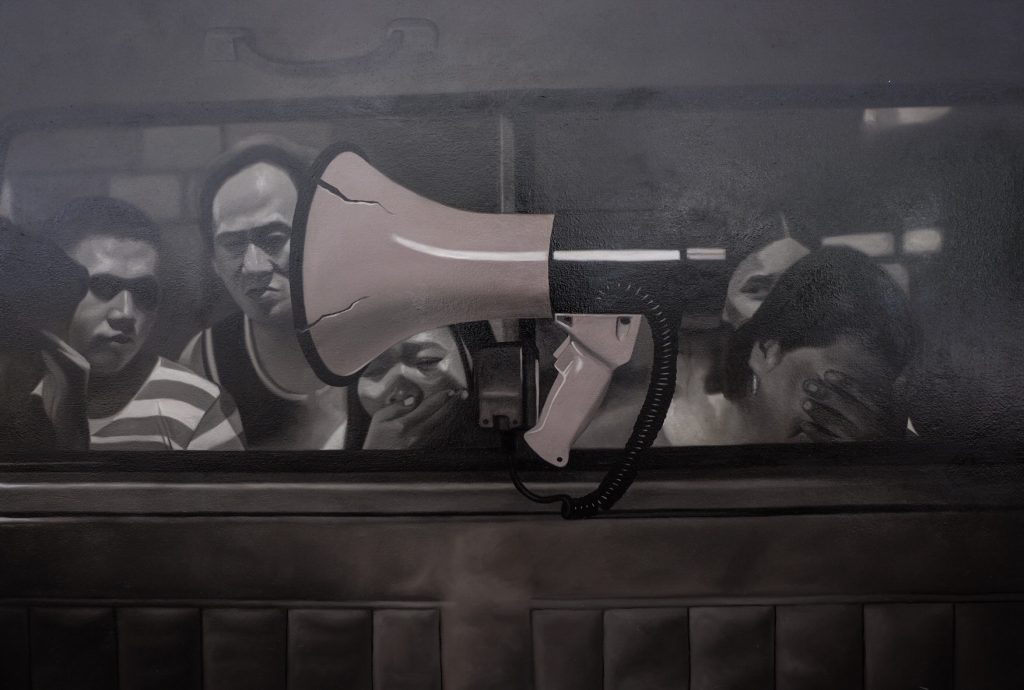IN DIRE STRAITS
Lendl Arvin and Jett Osian
December 15 - December 28, 2017

In Dire Straits
Spanning as early as the Propaganda Movement of the late 19th century and taking on a critical role during the Marcos regime in the 1970s and 80s, social realism in the Philippines holds a rooted, complex history. Amidst this narrative, two emerging artist endeavor to make their mark in response to the social landscape of the present times. Refusing to turn a blind eye to the plight of their countrymen, Lendl Arvin and Jett Osian reflect an awareness of our deeply layered history and how what is currently occurring, though different, is connected to this past.
The incidents being depicted are all too familiar in the Philippine context: the plight of farmers and migrant workers, unjustifiable massacres, and an unending chain of extra- judicial killings. As they confront these recurring issues, Arvin and Osian incorporate their own distinctive styles. Arvin’s dulled colors evoke a quiet, dark mood supplemented by a rough, unfinished quality seen in erasure markings, splotches, and drips. Osian’s monochromatic, polished style stripped of color brings to light a contrast heightening drama in the scenes. Though human figures are consistent among the works, there is a clear focus on objects as a vital component. Electric bills folded into origami shapes, a cracked megaphone, a broken tire, a vintage TV—these are items that stand mundane on their own, but are rich in symbolisms and meaning when put in the context of events in recent history.
Though evidently reflecting influences from the social realism that emerged in the 70s and 80s through overlapping themes and subjects, there are clear variances. While much of the art of that era would be direct and prescriptive, the works of Arvin and Osian are subtle and open-ended. Whereas freedom of press was halted and access to news was limited then, exposure to gut-wrenching, photojournalistic images of injustice and oppression is rife in this digital age. This is a phenomenon specific to this moment in history–something that Arvin and Osian display a deep consciousness of. As a result, these images have become significant references in the paintings.
Nevertheless, the works are far from a detached documentation of the contemporary social landscape. In delicate ways, they hold a personal tone. The selection of the subjects and issues depicted were born out of a deep-seated experience between the two artists. The concept of working double jobs remains close to Arvin, having taken on the role as the caretaker of his grandfather as a young child. Osian’s frequent watching of mainstream media, which revealed a lack of due process present in the country, has instilled in him a fear of running the risk of being a victim himself.
The focal works of Arvin and Osian, Luisa and Predicament 1 respectively, depict two historical events over a decade apart: the Hacienda Luisita Massacre of 2004 and the extra- judicial killings plaguing the country today. Rather than being a blur on the sidelines or mere collateral damage, the faces of their victims take center stage. They are haunting and vivid— none of which look straight to the viewer, but they call out and command a response all the same. Two distinct events that took place at different times, affected different victims, and were created from different perspectives raise similar, echoing questions. Justice for the voiceless and the lingering reality of history repeating itself—Arvin and Osian implore viewers to ponder on these issues, lest we perpetually remain in dire straits.
—Nicole Soriano